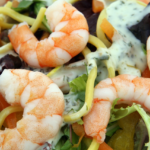Have you ever wondered if it’s safe to eat shrimp shells? As a seafood lover, I’ve often been tempted to try eating the whole shrimp, but concerns about potential health risks have held me back.
After doing some research, I’ve learned that there are both benefits and drawbacks to consuming shrimp shells.
On one hand, the shells of crustaceans like shrimp are rich in chitin, a fibrous substance that has been shown to have various health benefits such as reducing inflammation and aiding in weight loss. Additionally, many cultures around the world consume shrimp with their shells intact for added texture and flavor.
However, there are also potential risks associated with eating these shells such as contamination from bacteria or chemicals used in processing.
In this article, we will explore the nutritional value of shrimp shells, the risks of consuming them raw or undercooked, and alternative ways to use them in cooking and sustainability practices.
Key Takeaways
- Shrimp shells have health benefits due to their chitin content and can aid in digestion, improve cholesterol levels, and promote joint health.
- Eating shrimp shells is a cultural practice in some countries, but it may pose risks of constipation and allergies, and is not recommended for pets due to potential choking hazards and intestinal blockages.
- Proper cleaning and preparation is important when cooking shrimp with shells to avoid contamination from bacteria or chemicals used in processing.
- Sustainable seafood practices include reducing waste, choosing responsibly sourced options, and supporting healthy oceans by buying local shrimp from environmentally friendly fisheries and looking for labels like ASC and MSC that certify sustainable and ethical production.
The Nutritional Value of Shrimp Shells
Did you know that shrimp shells are not only edible but also provide valuable nutrients? Shrimp shell supplements have been found to be a good source of chitin, which is a fiber that can aid in digestion and support healthy gut bacteria. Chitin is also known to have anti-inflammatory properties and may improve cholesterol levels.
Incorporating shrimp shells into pet food has become increasingly popular due to their nutritional benefits. Shrimp shells contain high levels of glucosamine, which can promote joint health and reduce inflammation in pets. Additionally, the chitin found in shrimp shells can help regulate the digestive system of animals.
It’s important to note that while eating shrimp shells can be safe for humans, it’s best to avoid giving them to pets as they may pose a choking hazard or cause intestinal blockages.
The Risks of Eating Shrimp Shells
You wouldn’t want to walk barefoot on broken glass, just like you wouldn’t want to risk the sharp edges of shrimp shells cutting your insides. While it may be tempting to eat the entire shrimp, including the shell, there are health concerns associated with doing so.
Shrimp shells contain a tough substance called chitin that is difficult for our bodies to break down. Consuming large amounts of chitin can lead to constipation or even intestinal blockages.
Additionally, some people may have an allergy or sensitivity to shrimp shells, causing symptoms such as stomach pain, nausea, and vomiting. To avoid these potential health risks, it’s best to stick with eating only the meat of the shrimp and discard the shell.
Preparation and Cooking Techniques
Get ready to elevate your shrimp dishes with these expert tips on preparing and cooking this delicious seafood.
When it comes to eating shrimp shells, proper preparation is key. Before cooking, be sure to clean the shells thoroughly by using a brush or scrubber to remove any dirt or debris. Once cleaned, you can season the shells with your favorite spices such as garlic powder, paprika or cumin for added flavor.
When cooking shrimp with the shells on, there are several options for seasoning and preparation. One popular method is grilling – simply marinate the shrimp in olive oil and lemon juice, sprinkle salt and pepper over the shells and grill until they turn pink.
Another option is sautéing – add butter or olive oil to a pan along with minced garlic and chopped onion, then toss in the seasoned shrimp shells until cooked through. Regardless of how you choose to cook them, remember that eating shrimp shells can provide additional nutrients such as calcium and chitin while also adding texture and flavor to your dish.
Alternative Uses for Shrimp Shells
Looking for creative ways to enhance your seafood dishes? Consider repurposing the shells leftover from your shrimp meals. These shells can actually be quite useful, providing a variety of benefits beyond just being an ingredient in your meal.
Here are some alternative uses for shrimp shells that you may not have considered:
-
Gardening fertilizer: Crushed shrimp shells can be used as a natural fertilizer to improve soil quality and promote healthy plant growth. The high levels of calcium and chitin found in shrimp shells make them particularly effective in boosting soil health.
-
DIY home decor ideas: Shrimp shells can also be used to create unique and interesting home decor items. For example, you could glue them onto a picture frame or mirror to add texture and visual interest, or use them to create a mosaic design on a tabletop or other surface.
By finding new ways to use shrimp shells, you can not only reduce waste but also enjoy the many benefits they have to offer. Whether you’re looking for ways to improve your garden or spruce up your home decor, these versatile shells are definitely worth considering!
Cultural Differences in Eating Shrimp Shells
If you ever find yourself dining with a group of locals in Japan, don’t be surprised if they enjoy the shrimp shells as much as the meat itself. This cultural significance has been passed down for generations and is rooted in their culinary traditions. In fact, it’s considered a delicacy in some regions of Japan.
Eating shrimp shells is not just limited to Japan though – many other cultures also incorporate this practice into their cuisine. In Thailand, for example, shrimp shells are used to make a flavorful broth that is often served alongside seafood dishes. Similarly, in Mexico and parts of South America, grilled shrimp with the shell still intact is a popular street food item.
These cultural differences only highlight the diverse ways in which people around the world view food and its consumption.
Sustainable Seafood Practices
As we continue our exploration of seafood, it’s important to consider sustainable practices.
At its core, sustainability means reducing waste and choosing responsibly sourced seafood. By doing so, we can support healthy oceans and ensure that future generations have access to the same abundance of marine life we enjoy today.
Reducing Waste
By composting shrimp shells instead of throwing them away, we can reduce waste and make a positive impact on the environment. Upcycling shrimp shells is not only an innovative way to reduce waste, but it also provides numerous benefits to our soil. Here are four reasons why composting shrimp shells should be considered:
1) Shrimp shells contain chitin, which is known to enhance soil fertility and improve crop production.
2) Composting shrimp shells reduces methane emissions, which are harmful to the environment and contribute to climate change.
3) It diverts organic waste from landfills where it may release greenhouse gases as it decomposes.
4) Composting shrimp shells helps to conserve landfill space and decrease the need for synthetic fertilizers.
Upcycling or composting shrimp shells is an effective way of reducing waste while giving back to the environment. By incorporating this practice into our daily routine, we can help sustainably manage our seafood industry’s byproducts while promoting healthy soil and minimizing pollution.
Choosing Responsibly Sourced Seafood
You may be surprised to learn that the seafood you choose at the grocery store or restaurant can have a significant impact on the health of our oceans and marine life.
When it comes to shrimp, choosing responsibly sourced options is crucial for reducing environmental impact and ethical considerations. Shrimp farming has been known to contribute to pollution, destruction of habitats, and overuse of antibiotics.
To make a more conscious choice when selecting shrimp, look for labels such as ASC (Aquaculture Stewardship Council) or MSC (Marine Stewardship Council), which certify that the product meets strict standards for sustainable and ethical production.
Additionally, consider buying local shrimp from small-scale fisheries that use environmentally friendly practices. By being mindful of where our seafood comes from, we can help preserve our oceans’ health while still enjoying delicious meals.
Frequently Asked Questions
How long can shrimp shells be stored before they go bad?
When storing shrimp shells, it’s best to freeze them in an airtight container. They can last up to three months. As for cooking techniques, shrimp shells make a great base for seafood stock or added flavor in soups and stews.
Can shrimp shells be used to make broth or stock?
We were looking for shrimp shell broth alternatives and found that using the shells to make stock is a great way to add flavor. Check out recipes with shrimp shell stock for soups, stews, and risottos – it’s delicious!
Do different species of shrimp have different flavored shells?
Different species of shrimp shells have varying levels of flavor, which can be used as a seasoning for dishes. Cooking with shrimp shells adds depth and richness to soups, stews, and sauces.
Are there any health benefits to consuming shrimp shells?
Shrimp shells are a good source of chitin, which has potential health benefits like aiding digestion and boosting immunity. However, they may also contain harmful contaminants. Some cultures use them in culinary traditions for flavor and texture.
Can shrimp shells be composted or used as fertilizer?
Shrimp shells can be composted or used as fertilizer, providing environmental benefits such as reducing waste and enriching soil. However, they should not be consumed by humans due to potential health risks from contaminants and allergens.
Conclusion
In conclusion, while shrimp shells may offer some nutritional benefits, the risks of consuming them outweigh any potential gains. It’s important to properly prepare and cook shrimp to avoid any potential foodborne illnesses or health complications.
Additionally, it’s important to consider sustainable seafood practices and not contribute to the overfishing of shrimp populations. Symbolically speaking, eating shrimp without removing their shells can be compared to taking unnecessary risks in life.
Just as we must take precautions and protect ourselves from harm in our daily lives, we must also exercise caution when it comes to what we eat. By being mindful of the potential dangers associated with consuming shrimp shells and making conscious choices about our seafood consumption habits, we can ensure a safer and more sustainable future for both ourselves and the environment.



